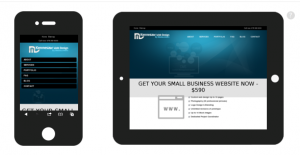
You must step up your mobile design game when looking to enjoy a view from the front. Based on the conversations with the design team, given below are some useful mobile design trends for 2016, presented by web design Kennesaw agency.
The main difference between the mobile and desktop screen is its size. The mobile apps and sites have less space and are simpler from desktop applications. This is where a layered interface helps as it helps in putting elements on top of each other.
The stacked interfaces such as pile of papers allow users to open, close, switch tabs and swipe away the screen. The setup conserves space with only one window at a time but with an easy access to the rest.
A few applications of the Layered Interface are:
A hamburger menu is used in all web applications which are not immediately relevant on the opening screen.
A minimal menu with only the essential elements remains on the screen while the user engages with the fluid screens outside.
A digital papers organizational method with a small clickable area of different pages is always available.
The layered interfaces also work in accordance with Google’s material design mimicking how the people organize and interact with the documents in the real world. Shuffling the pages around with the most important message on top is what we need to do without thinking. You can consider gradient shadows and the full fade out on the secondary layers for accenting the layered format. This will act as a visual cue for how the users interact with different levels.
Tapping and swiping are as instinctual as clicking and pointing by now. The touch screens have got a lot of potential usability than the cursors, almost endless potential depending on user creativity. For setting the mobile site or app, you need to work on this creativity.
However, you don’t need to reinvent the wheel. The creative gestures are not something which can be packed, as each requires recall and learn ability, taking the UI farther away from the “intuitive.” The mobile design trends 2016 only use a new gesture when improved an old form of interaction, making it fast, natural and comfortable.
The Microinteractions started as a delightful little flourishes enhancing the interfaces enjoy ability with little ease. The designers have realized that the tiny and unnoticed moments serve deeper with practical purposes. You will see their use more and more in the future. A microintention is anything from a momentary animation to a sound effect. The microintention nature is flexible; however, it should be used to follow a few predefined guidelines to make the most of it.
Using a micro interaction for any of the above reasons goes beyond mere enjoyability — it improves usability, learn ability, and creates a more efficient functionality. In 2016, micro interactions will be used more and more to fill in the “cracks” of an interface.
Typography needs to be meaningful on the screen. Words on mobile devices play a crucial role. Not changing the typography from the desktop version to create a mobile site or app is hard to use and read. The idea is to balance the legibility with space conservation. This is why, simpler typefaces are chosen as these are easy to read at the small sizes. Characteristics such as rounded edges and sans serif also fit in with the aesthetic styles of minimalism and the flat design, according to the trends of 2016.
Even though there is no failsafe point to deal with these completely, following the advice will eliminate many problems. For the large block of text, you can use a left alignment. The complements are natural reading rhythms dedicated us to reading every word. From small text bits to a center alignment, headlines, calls-to-action and center alignment improves visibility and less awkward hanging text. The right alignment is used to control a setting such as short title, forced breaks after each word.
The card layout has revolutionized both the mobile and desktop browsing, meaning that designers are looking for new ways to improve it. As time moves on, the mobile cards are becoming smaller, effortless transition into an offshoot buttons.
Cards used as a way for organizing the information into bite-sized doses so users can choose what they are looking to interact or ignore. Social media giants such as Twitter, Facebook and especially Pinterest has brought this card type design as the mainstream way to make sense of the otherwise chaotic mess of the user generated content.
Typical card format contains the following elements:
Card design has done an amazing job for the mobile UI as these were less restricted by the different screens sizes. When breaking an entire page of content into manageable blocks, devices with different screen sizes, the designer needs to reorganize the different placements of these blocks without losing any meaning.
Card design improves the responsive functionality and the more popular a pattern becomes the more recognizable its usability becomes. Some companies can’t work for all products however the spirit behind the trend is gaining popularity. It shows the bare essentials on every card to conserve space and reveals the entire content after clicking.
The idea is to scratch the surface of what is in stores for mobile design in 2016. For more details, check out the Medialinkers responsive web design services.